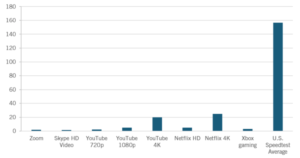There seems to be a widespread misnomer that consumers will never have enough bandwidth. Internet users are preoccupied with internet speed.
Of the 78 million broadband active users in the US, 50% are now reported to be on a broadband plan that delivers speeds of at least 195 megabits per second (Mbps) – more than enough to accommodate the needs of the average American household. Video streaming like for example Netflix Ultra HD uses about 12Mbps, while video conferencing over Zoom or another platform only requires 2 – 3Mbps. Also, online games such as Fortnite can work seamlessly with data speeds as low as 3Mbps. Below are some common bandwidth requirements for common application categories:


Source: ITIF.Org Report 2020
Many providers would have you believe that to maintain a frictionless internet experience you need more data. A large ISP outlines this in their FAQs: 

So why do we still experience video freeze, game lag spikes, and teleconference stutters? The problem is not necessarily speed, but rather factors such as latency, device working together, and even interference from your neighbor. And many other factors which are unrelated to speed.
For more than three decades we have been conditioned to think of broadband in terms of Mbps. This was true in the dial-up days when internet sending capability was 64Kbps. Today’s broadband is a great deal faster – at least by 10 times and more.
In the modern era where high-speed internet approaches 200 Mbps and above, broadband speed has become a non-issue. Studies from the Broadband Forum outlines that the increase in speed is largely unnoticeable to users.
In contrast to our need for speed, our online time has grown tremendously. With social distancing and the policy of working from home, US household are consuming more broadband than ever. In addition, internet speeds have surged as the cost of cable’s broadband services declines. In the last 20 years internet costs have dropped by 98% (when comparing the price per megabit today).
Moving away from Mbps and towards Quality of Experience
What consumers basically want from broadband providers is a high level internet experience. A frictionless connection that offers low and comparatively constant latency and loss. And these factors in turn depend on how well ISPs/CSPs engineer tune their network.
One common tool used to reduce latency is deploying local caches, reducing the way data travels and therefore making it available faster. Packet loss can be managed by temporarily keeping packets in buffers, which flattens-out transient load spikes.
To manage loss, CSPs/ISPs can “shape” traffic by temporarily holding packets in buffers to smooth out transient load spikes. But there’s a natural trade-off here: too much smoothing holds packets back, leading to latency spikes that cause stutters and glitches. Too little smoothing, on the other hand, causes buffers to overflow and packets to be lost, which puts the brakes on downloads.
Since ISPs and CSPs don’t have any real way of controlling or managing their subscribers’ connected home ecosystem, an alternative approach to measure Quality of Experience is required.
Embracing the Power of AI in Measuring and Analyzing Internet Performance
With advances in artificial intelligence technology, it is now possible to analyze network traffic streams to assess users’ experience in a context-aware manner. By better understanding the unique profile of their subscribers and their connected home network, ISPs and CSPs can adjust and personalize their internet experiences.
For example, AI engines can detect simultaneously running services (let’s say Netflix and Fortnite), analyze how their connectivity requirements impact each other, and whether adjustments in the channel or resolution can improve the Quality of Experience of both. Same with pretty much every single service and device consumed within the household. Worth mentioning is that these solutions can also help identify root causes of connectivity problems and support the subscribers or customer support teams to pinpoint and resolve them (for example suggest a mesh-extender to improve WiFi coverage in rooms furthest away from the router).
To truly optimize internet performance, broadband providers need to understand the customer. Each customer. Each household.
This is where Veego’s contextual aware solution comes into play. Veego’s contextual aware home connectivity methodology delivers exceptional customer experiences and a significant competitive edge for providers.
What is Contextual Awareness in the Connected Home?
Contextual awareness in the connected home is the use and analysis of data collected from home devices, services, and applications to improve consumer experience. This data is of incredible value to ISPs and CSPs (but also to device and app vendors, as well as entertainment service providers) to understand the performance of their product within the context of the connected home. This can help to identify potential flaws, understand trends and developments early on, and gain insights into the behavioral preferences of the audience.
Essentially the context aware connected home empowers both ISPs/CSPs and homeowners to improve their Quality of Experience. It represents the next generation of the connected home and is the basis of intelligent, truly personalized home connectivity.
Why is Veego’s Contextual Aware Solution Unique?
Veego’s solution uniquely measures and analyzes every connected device, service, and application in the connected home. Essentially creating a home fingerprint, a unique profile of every home – learning the unique intricacies of its residents’ device and application usage and Internet behavior. Using Artificial Intelligence Veego strives to understand the user’s intent, allowing it to generate unmatched insights about the usage, satisfaction, and potential problems of consumed services, and empowers internet subscribers as well as ISPs and CSPs to perfect their customer experience.
So next time you stress about slow internet, consider whether your provider is optimizing performance using the latest solutions.





